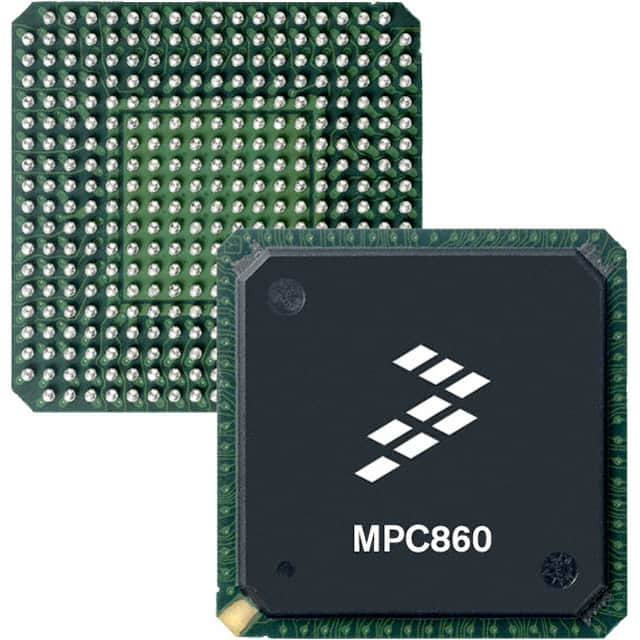Consulte las especificaciones para obtener detalles del producto.

MPC860PCVR50D4
Product Overview
- Category: Integrated Circuit (IC)
- Use: Microprocessor
- Characteristics: High-performance, PowerPC architecture
- Package: Ceramic Quad Flat Pack (CQFP)
- Essence: Advanced microprocessor for embedded systems
- Packaging/Quantity: Individually packaged, quantity varies based on order
Specifications
- Manufacturer: NXP Semiconductors
- Model Number: MPC860PCVR50D4
- Architecture: PowerPC
- Clock Speed: 50 MHz
- Data Bus Width: 32-bit
- Address Bus Width: 32-bit
- Cache Memory: 8 KB instruction cache, 8 KB data cache
- Operating Voltage: 3.3 V
- Operating Temperature Range: -40°C to +85°C
- Package Type: Ceramic Quad Flat Pack (CQFP)
- Pin Count: 357
Detailed Pin Configuration
The MPC860PCVR50D4 has a total of 357 pins. The pin configuration is as follows:
- Pins 1-20: Power and Ground Pins
- Pins 21-60: Address Bus Pins
- Pins 61-100: Data Bus Pins
- Pins 101-120: Control Pins
- Pins 121-140: Interrupt Pins
- Pins 141-160: Clock Pins
- Pins 161-200: I/O Pins
- Pins 201-240: Additional I/O Pins
- Pins 241-280: Serial Interface Pins
- Pins 281-320: DMA Pins
- Pins 321-340: JTAG Pins
- Pins 341-357: Miscellaneous Pins
Functional Features
- High-performance microprocessor designed for embedded systems
- PowerPC architecture provides efficient processing capabilities
- Integrated cache memory enhances performance by reducing memory access time
- Supports a wide range of peripherals and interfaces for connectivity
- Built-in DMA controller for efficient data transfer
- JTAG interface for debugging and programming
Advantages and Disadvantages
Advantages
- High-performance processing capabilities
- Power-efficient design
- Wide range of peripheral support
- Integrated cache memory improves performance
- Suitable for embedded systems
Disadvantages
- Relatively low clock speed compared to modern processors
- Limited availability of alternative models
- May require additional support components for complete system integration
Working Principles
The MPC860PCVR50D4 microprocessor operates based on the PowerPC architecture. It executes instructions and processes data using its internal ALU (Arithmetic Logic Unit) and control units. The processor communicates with external devices through various interfaces, such as serial ports, DMA channels, and interrupt pins. It utilizes cache memory to reduce memory access time and improve overall performance.
Detailed Application Field Plans
The MPC860PCVR50D4 microprocessor is widely used in various embedded systems applications, including:
- Industrial Automation: Control systems, robotics, and factory automation.
- Networking Equipment: Routers, switches, and network appliances.
- Telecommunications: Voice over IP (VoIP) gateways, PBX systems.
- Automotive Electronics: Engine management systems, infotainment systems.
- Medical Devices: Patient monitoring systems, medical imaging equipment.
Detailed and Complete Alternative Models
While the MPC860PCVR50D4 is a popular choice for many embedded systems applications, there are alternative models available from different manufacturers. Some notable alternatives include:
- Freescale MPC5554: Another PowerPC-based microprocessor with higher clock speed and advanced features.
- Intel Atom E3845: x86-based microprocessor suitable for low-power embedded applications.
- Texas Instruments OMAP5432: ARM-based microprocessor with multimedia capabilities.
These alternative models offer different performance levels, features, and compatibility options, allowing developers to choose the most suitable option for their specific application requirements.
Word count: 511
Enumere 10 preguntas y respuestas comunes relacionadas con la aplicación de MPC860PCVR50D4 en soluciones técnicas
Sure! Here are 10 common questions and answers related to the application of MPC860PCVR50D4 in technical solutions:
Q: What is the MPC860PCVR50D4? A: The MPC860PCVR50D4 is a microprocessor unit (MPU) manufactured by NXP Semiconductors, designed for embedded applications.
Q: What are the key features of the MPC860PCVR50D4? A: The key features include a PowerPC architecture, clock speed of 50 MHz, integrated memory management unit (MMU), multiple communication interfaces, and low power consumption.
Q: What are some typical applications of the MPC860PCVR50D4? A: The MPC860PCVR50D4 is commonly used in networking equipment, industrial automation systems, telecommunications devices, and automotive electronics.
Q: Can the MPC860PCVR50D4 handle real-time processing requirements? A: Yes, the MPC860PCVR50D4 is capable of handling real-time processing tasks due to its high-performance architecture and integrated peripherals.
Q: What operating systems are compatible with the MPC860PCVR50D4? A: The MPC860PCVR50D4 supports various operating systems such as VxWorks, Linux, and QNX, making it versatile for different software environments.
Q: How much memory can the MPC860PCVR50D4 address? A: The MPC860PCVR50D4 can address up to 4 GB of physical memory through its integrated MMU.
Q: What communication interfaces are available on the MPC860PCVR50D4? A: The MPC860PCVR50D4 offers interfaces like Ethernet, UART, SPI, I2C, and CAN, enabling seamless connectivity with other devices.
Q: Can the MPC860PCVR50D4 operate in harsh environments? A: Yes, the MPC860PCVR50D4 is designed to withstand harsh operating conditions, including extended temperature ranges and high vibration environments.
Q: Is the MPC860PCVR50D4 still in production? A: It's recommended to check with NXP Semiconductors for the latest information on the availability of the MPC860PCVR50D4 as it may vary over time.
Q: Are there any development tools available for programming the MPC860PCVR50D4? A: Yes, NXP provides a range of development tools, including software development kits (SDKs), compilers, debuggers, and evaluation boards, to facilitate programming and testing of the MPC860PCVR50D4.
Please note that the answers provided here are general and may vary depending on specific requirements and application scenarios.

